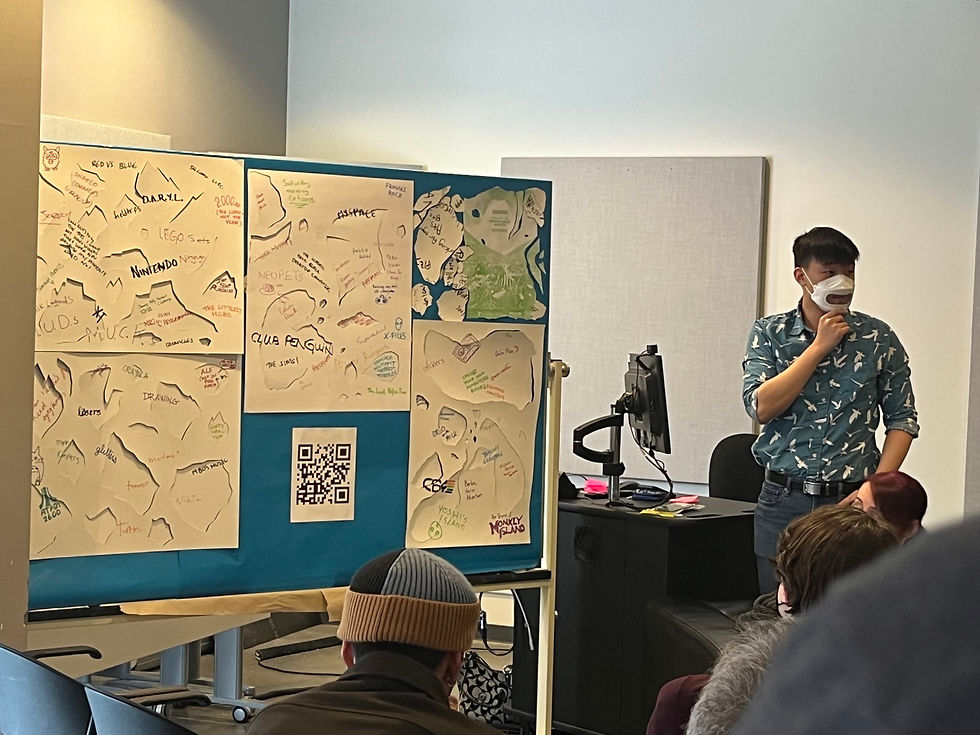Nostalgia for the Future... with a Board?
- Richy Srirachanikorn

- Mar 30, 2023
- 5 min read
“One is nostalgic not for the past the way it was, but for the past the way it could have been.”
This wisdom from Svetlana Boym’s The Future of Nostalgia (2001) is still with me, four years on. When we focus on past, we are often LOST in our feelings, memories, and emotions. And often, this quest leads to more losses: time away from others and activities; the e-waste of new devices and consoles that boast the ability to restore the past; energy consumption from the servers that carry our infinite digital albums; and a constant yearning for the past that distracts us from living in the present.
When we relive our memories through our technological devices, we are chasing all that is “Lost.” But in this search, more losses keeps us “Lost Again.” What can we make of these experiences? Can digital nostalgia be extended towards a productive social outcome? Can it be more than just entertainment or respite? Can something be "found" out of this?
Honing on a form of generative nostalgia, my colleagues and I from the TAG Research Centre, founded the Nostagain Network in 2022 to bring together artists, scholars, and media creators to ponder this question: Can something be "found" from the losses of our memories and the losses that come with our digital time travelling?
This question led to the formation of Nostagain Network's LOST/AGAIN Symposium on February 4th, 2023, at Concordia University's Milieux Institute.

At the symposium, I presented a workshop titled Global Warning, which was a large moveable board with four large papers taped onto a blue backdrop. Throughout the day, as numerous panels and workshop sessions were taking place, the board -- stationed in the hallway and next to the food stand -- allowed participants to jot down their reflections about nostalgia.
At the end of the symposium, the board was filled to the brim with snippets of childhood cartoon titles, significant world events, people’s memories of pre-pandemic life, and obscure forms of media. Global Warning demonstrated that we are constantly “Lost Again” in our pasts. Simply put, we have become full-time nostalgics. But interestingly, people were talking about the future, too: "I wish they would make a new Club Penguin for us today", "Hey, did you see the news about the remake of this show?", "No way! You played with the original LEGO Bionicle as well? Let's make a club at Concordia!"
Soon enough, this nostalgic board turned from a holder of "Lost" things; a site of people who were "Lost Again" in their nostalgia; and a forum for what could be "Found" from it.
Towards the end of the symposium, I invited four volunteers to tear down the sheets of paper on the wall, leaving behind pre-cut out shapes that were taped to the backdrop. There, we saw a mural of melting memories resembling the polar ice caps that speak to what the planet has "lost", and our efforts to "find" solutions for it.
This research creation activity ties with Boym’s (2001) idea of creative nostalgia, which "reveals the fantasies of the age, and it is in those fantasies and potentialities where the future is born". Boym wisdom at it, again.
Global Warning’s lasting image presents three key ideas about how we can think about "nostalgia for the future".

First, nostalgia is not an individual experience, but a collaborative one.
It took everyone's effort to fill the wall throughout the day. To make a "nostalgia" board, you need people's memories! Without this collaboration, the wall remains a blank canvas.
But these thoughts were not unprompted.
Participants rarely stood alone at the board, pen in their mouths, thinking -- pairs and threes filled the board together, laughing and contesting the value of each other's nostalgia. "What, you are nostalgic for that version of Tekken?!".
Outside these crowds, solitary wall-fillers drew inspiration from the workshops and the panels throughout the day or the internet, browsing the exact model, date, or serial code of their cherished memorabilia. Some nostalgic entries were even written in response to the panel and workshop claims about nostalgia made throughout the day.
In this sense, the wall would be nothing without the symposium around it.
Even with close to fifty entires, no single sentence or phrase can capture what nostalgia truly means. A person’s childhood dog or the desire to go back home are all nostalgic things, but they are not experienced in the same way by everyone.
As such, nostalgia requires the collaboration of participants to communicate what and why they are yearning for something; the writing's on the wall, but the why is on the writer.
Second, nostalgia requires an active effort to remember why we remember.
After the tear down, people's memories "melted" away. The losses that occurred were two-fold: the original nostalgic entry is now "Lost" forever, torn away and incomplete.
But in the blue sea of destruction, participants now re-read the broken entries by piecing them together. Some, of course, did not work: "My fluffy... Campbell's soup... 2003". Yet those that did, worked wonders: "Childhood... Atari 23... my grandma". This last one set a scene for many; playing their first consoles, often at home, waiting for dinner or the school bus, and seeing their family members walking around.
things became blurry when sentences written by different people were read as one after the tear down. This resembles our memories and histories which are often lost, or blurred.
Boym reminds us that nostalgia "melts" without the constant effort to maintain it. This can be a narrative of the past that some people are Making Great Again, it can be a constant production line and marketing of "retro" T-shirts, or... it can also be our imagination -- filling, piecing, and "finding" what was lost.
The disease of the century, Boym theorizes, is the “vanishing present” (2001:351). Whilst nostalgia unites people together, it can also be a source of opposition, because no one can remember everything that has been lost.
It is in the "finding" of what was lost, that we are "Lost Again"... misinterpretation, missing pieces for the full picture, the context... all lost in translation.

Finally, nostalgia can be a playful invitation to think about
what was lost, what we are losing, and what our this means for the future.
Research creation activities such as the Global Warning wall can teach these lessons after prompting people be “Lost Again,” tearing apart the things which they’ve brought back onto the board. By highlighting the precarious but social nature of nostalgia, we have “found” the generative potential of things that aren’t digital (e.g., the blackboard wall) which revealed something about the relationship between our technology and desires.
The board is playful -- it's just a student-led symposium activity -- but 'boards' like this exist elsewhere with more gravitas: Facebook pages where people fight tooth and nail to decide what posts (and posters) qualify as a nostalgic 80s things, 1920s car meetup groups that exclude new recruits depending on their age, race, and perceived inexperience... even if they had lived through it!
Nostalgia boards are everywhere. In re-remembering a "Lost" past, something is always excluded and re-included, even if it does not reflect the past "for the way it was" (Boym).
Instead, these boards -- online forums, history books, period films, cultural representation, political debates, newspapers, etc. -- engage its users to be "Lost Again".
Only when there is an active, collective, and playful context to explore this, can nostalgia generate something useful -- something insightful about us then and now -- for the future.
Global Warning received funding from the Hexagram Research Network (2023) and the Dean's Special Initiative Award (2023) from Concordia University.




![[News Excerpt] The Rise of Retro Games and the 'Cost' of Nostalgia](https://static.wixstatic.com/media/f15f7f_8254c28e489f4955b4ad1db6a7ee1488~mv2.png/v1/fill/w_980,h_980,al_c,q_90,usm_0.66_1.00_0.01,enc_avif,quality_auto/f15f7f_8254c28e489f4955b4ad1db6a7ee1488~mv2.png)


Comments